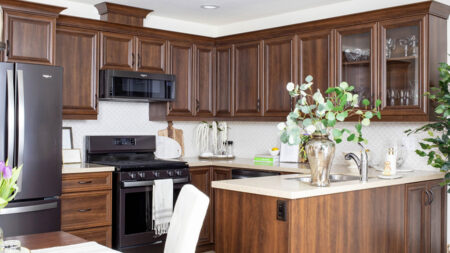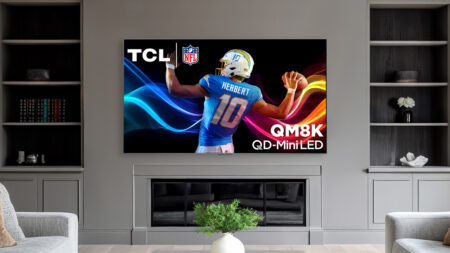Mounting a TV on a wall is becoming a highly popular way of setting up a television. Why? Well, a wall-mounted television can save up space and also make a room appear bigger. A TV looks too big when you place it on a stand but it appears less imposing when mounted on a wall.
Another reason why many people go for the wall-mounted TV option is that it even prevents tip-overs or unwanted accidents/injuries. So, if you have kids at home, you need to consider mounting your TV on a wall. But before installing your TV on a wall, you need to choose the right mount equipment for it. But, how would you do that?
In this article, we discuss various types of TV mounts, the benefits of wall mounting a TV, and ideas to consider for placing a TV on a wall.
What is a TV wall mount?
As the name indicates, a TV wall mount is an equipment to help you attach your TV to a wall. Whether you choose to wall mount your TV in a bedroom or living room, you can place the wall-mounted TV across your seating to enjoy your favorite shows from a comfortable position.
Wall mounting a TV is not as simple as installing it on a stand. It needs some effort to attach a mount on the wall and then install a TV on it. If you don’t know how to drill holes or use the tools for installing a mount, you may have to seek professional assistance.
Many TV sets come with a basic, low-profile wall mount. Some TV makers provide free installation for them. But if your TV doesn’t come with a wall mount, you’ll have to take home a separate one, compatible with your TV, from the market.
How to wall mount a TV?
Find a location to install your TV
Decide on which wall you want to install a TV. Ask someone to hold it for you against the wall at different heights and places. This way, you can check how a screen would look while you sit or stand. You may want to use a measuring tape to ensure the TV is mounted at an adequate distance from the couch.
Ideally, the distance from the center of the TV and the flooring must be around 56-inches for a 42-inches TV, 61-inches for a 55-inches TV, and 65-inches for a 65-inches TV, and so on. The position where you want to mount a TV is again defined by the seating arrangement and an individual’s viewing comfort. Typically, a viewing angle should be between 10 and 30 degrees above one’s eye level. Another significant thing ensure that the TV set is not in line with light glare and there are ample power outlets accessible from where the TV will go up.
Mark studs
After deciding the spot where you want to install a wall mount for the TV, use an electric stud finder. It will help you identify a stud or simply pairing with the studs behind a wall. You have to find the centers and then mark those locations. Check that you have found a stud by slightly hammering a nail into a wall. When mounting a TV to a brick, drywall, or metal without studs, you require anchors or toggles to hold the TV’s weight. It should hold a TV without putting any stress on a wall.
Mark and then drill the pilot holes
Hold a mount against the wall just above the studs. Further, use a level to make sure that it is perfectly leveled. After that mark the exact points where you want to drill pilot holes and start drilling.
Attach the TV wall mount
Again, put a TV wall mount in position to ensure it is level and well-lined with the drilled pilot holes. Now, screw it into a wall or ceiling (where you prefer) using a drill.
Attach the wall mount bracket to a TV
Now locate the places on the TV where you have to attach the screws. The screws on the TV are supposed to screw onto the mount using the given holes. With swivel, tilt, or ceiling mounts, you need to do it up against your wall.
Fix the TV onto your wall
If you have not already attached it, connect the TV’s mounting bracket to a wall mount. Carefully read the instructions that come with your wall mount before installing it.
Also Read: Things to Consider Before Mounting Your TV Over Fireplace
Types of TV wall mounts
Here are various types of TV wall mounts to consider for your television:
Low-Profile Wall Mount
It is also called a flush- or flat-mount bracket. It is a simple type of wall mount with a metal frame to secure a TV on a wall, just like a photo frame. This TV mount sits between 1-inch and 2-inch from a wall. Since it is fixed in one position, it cannot tilt, pan, or rotate. It is one of the simplest and most convenient TV mounts to install. It comes with a wall-attaching bracket along with one flat plate or two upright posts to fix the TV’s rear. Although it makes it hard to manage rear cables, it is an ideal option if you don’t want your television to take up extra space.
Tilt Wall Mount
This wall mount is ideal to install your TV right over a fireplace. These mounts install and also appear just like the low-profile mounts. However, its two upright posts are easy to adjust for angling a TV down or up to the desired position. The tilt mounts generally cost more than the fixed mounts. But they also offer more space for rear TV cables and help you avoid glare in bright surroundings.
Swivel Wall Mount
It is an ideal TV mount for a corner of a room that needs a certain type of seating arrangement. Also known as articulating and full-motion mount, the swivel mount is easy to move from side to side, as well as up and down. In many cases, a swivel wall mount comes with a flat or bracket with a butterfly-shaped panel that fixes the TV’s back. A typical swivel mount can angle up/down in a similar way to a tilt mouth. However, it can even pivot on a jointed arm, which is easy to collapse and extend as per how far you like your TV to expand from a wall. It is slightly more expensive and difficult to install compared to tilt and fixed mounts.
Ceiling Mount
As the name suggests, this mount is easy to install on a ceiling for attaching your TV. It includes a ceiling attachment, and a fixed long arm to hold the TV from the ceiling. Plus, its bracket attaches to the TV’s back. This mount is also expensive and tends to be hard to install compared to other wall mounts due to the height of the ceiling. These mounts are dangerous if not installed properly. So, install them carefully or hire a professional to do the job for you.
Benefits of TV wall mounts
Have you had a TV stand previously? If so, you may understand the amount of clutter and dust it collects. But when you install a TV wall mount, it makes your room appear more tidy and organized. It even saves your flooring space while making the room appear more spacious.
Besides enhancing the decor, it also has the additional benefit of improving the overall viewing experience. Hence, it ensures that you are in your best position to snuggle up while enjoying your favorite programs.
Whether you want to tuck away your TV discreetly in a corner or position it as a centerpiece, choosing the right wall mount is essential. When you choose the correct TV bracket, you can attain the desired style in a room while maintaining the best position for viewing TV programs.
However, before buying a wall mount, you need to check how you want your TV to look in your house. Also, determine whether you’d like your TV to remain fixed in one position or would you prefer to tilt or swivel it. Based on that, you can choose the right type of TV mount for your home.
How to choose the best TV wall mount?
When choosing the right TV mount to suit your needs, figure out where you want to place it and how you’d like to view your TV. The fixed wall mount is very common but without maneuverability. On the other hand, tilt or full motion wall mount allows you to resolve the viewing problem. For instance, it can help you to see TV at distinct angles in a kitchen or keep it away from sight unless you want to enjoy your favorite TV show.
TV wall mount ideas
Given below are a few convenient and aesthetic TV all-mount ideas to enhance the visual appeal of your room:
TV mounted above media furniture looks modern and stylish
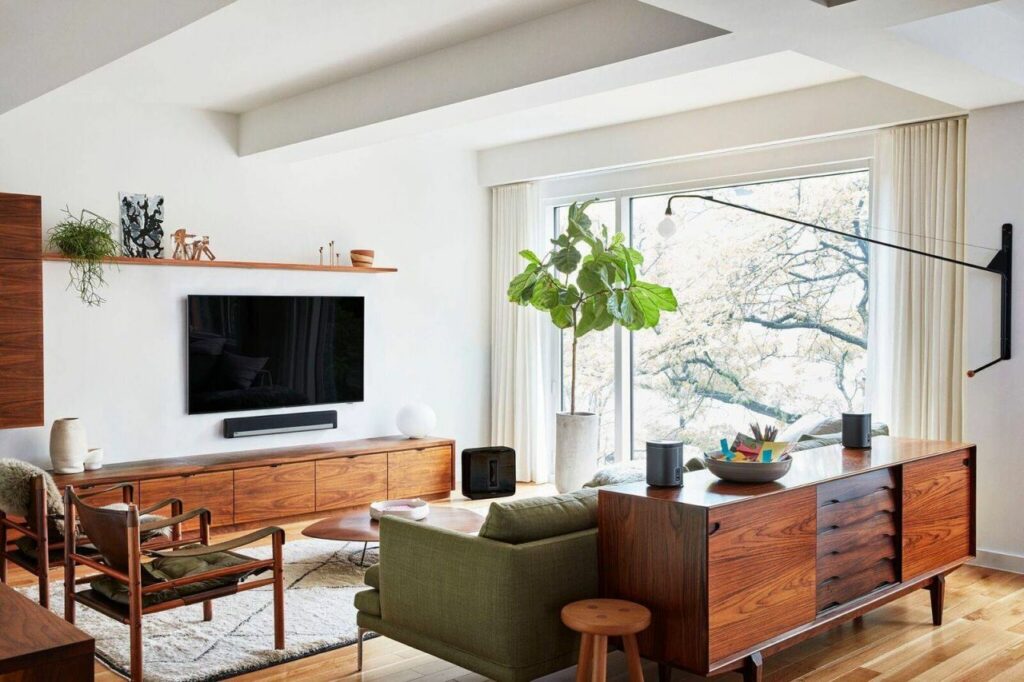
You don’t necessarily need media furniture for a wall-mounted TV. But to keep things more organized, you can keep a sleek media cabinet under a mounted television. If you have several components, like Blu-ray players, cable boxes, or gaming consoles, you can conceal them using a media cabinet. Hence, everything in your room seems to be more aesthetically appealing and sorted.
Place the TV above the fireplace
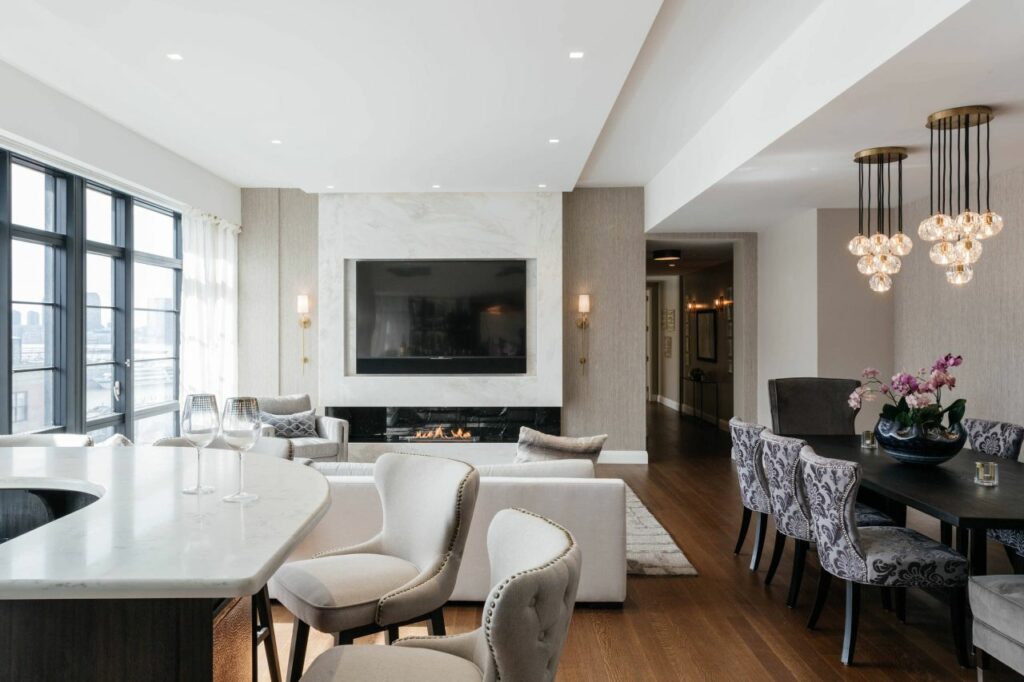
When you mount a TV just above a fireplace, it makes your TV appear like artwork. There are many other advantages of installing a TV above a fireplace. It mainly helps in keeping the TV and fireplace in one place. It also simplifies a room layout so you don’t have to arrange furniture for two separate focal points.
The wall next to the fireplace is perfect for the TV
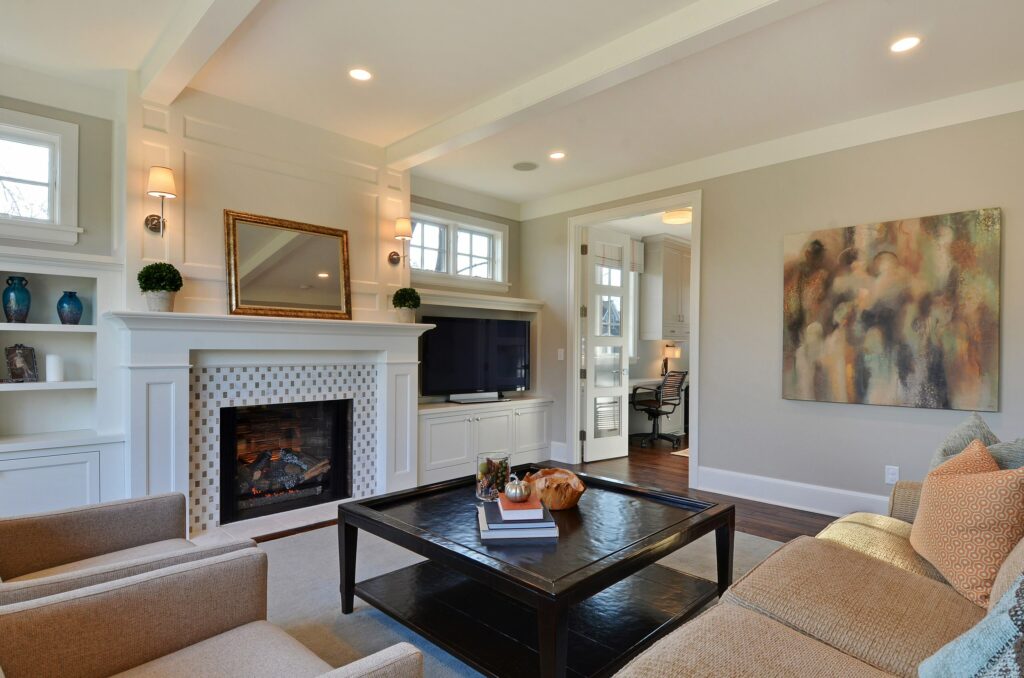
If you don’t care much about the look of a TV above a fireplace, you can install it next to a fireplace. Just like mounting a TV on a mantle, keeping it beside the fireplace also ensure both are nearby. It means you can still enjoy both without overthinking much about furniture placement or positioning.
The TV wall can be turned into a gallery wall with photo frames
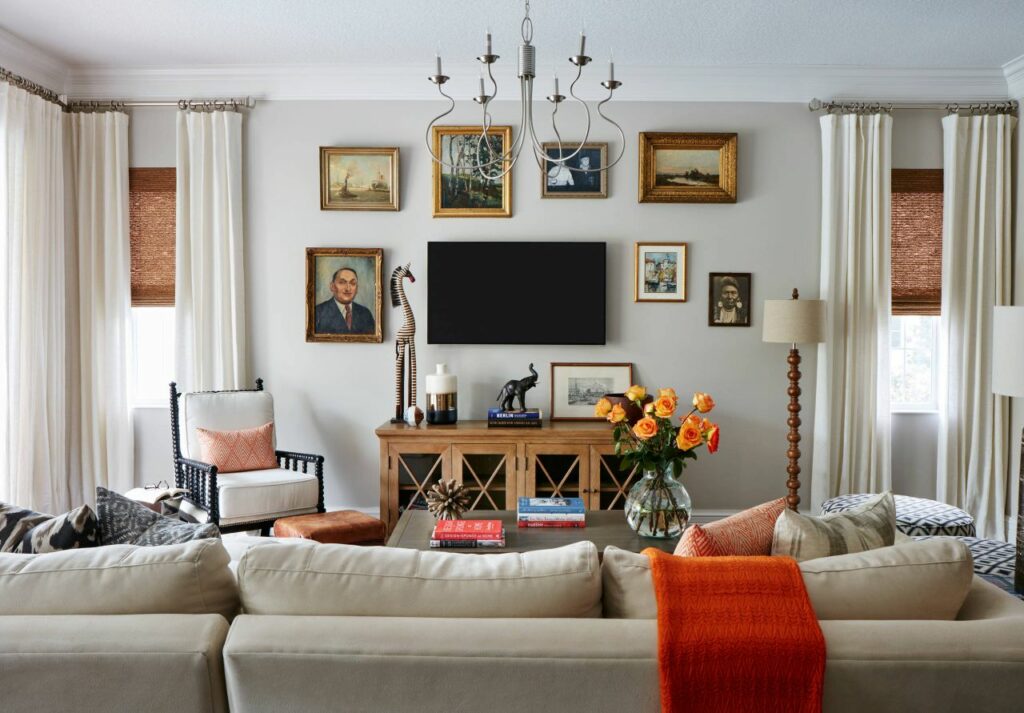
A TV gallery wall is a low-cost and quick way to upgrade a TV wall. Whether you prefer a traditional, bohemian, or something in-between style, a gallery wall is a great way to balance out TV with the overall aesthetic of a room. Meanwhile, this style helps in minimizing the impact of a television on a given space.
Also Read: 18 Most Popular Interior Design Styles Homeowners Should Know
You can even mount your TV in a corner
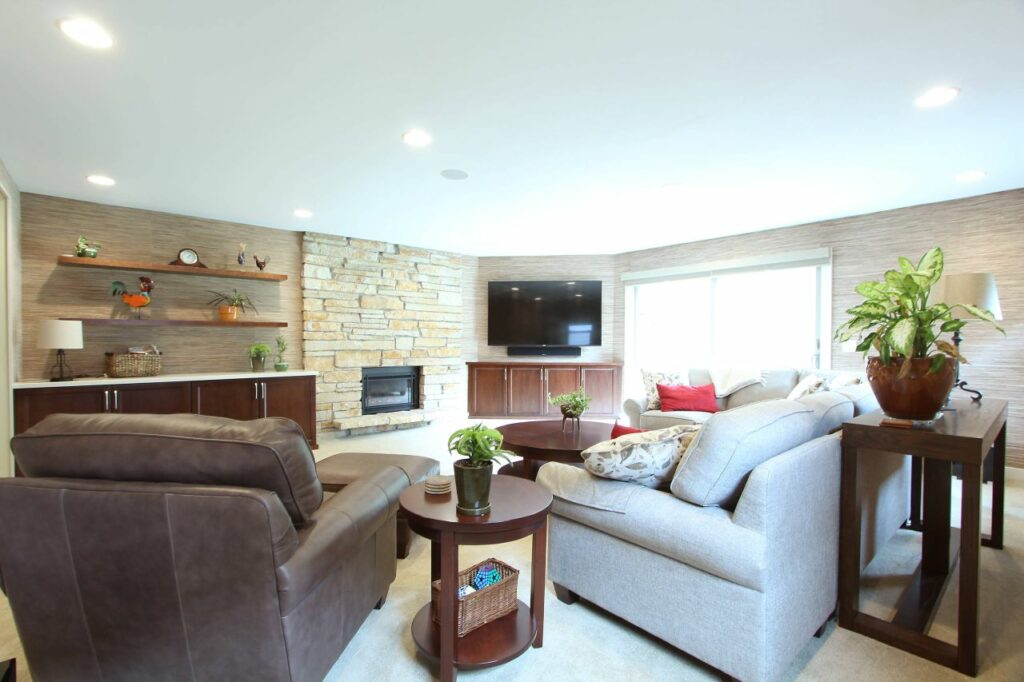
Well, for some people, a corner may not be an ideal place to install a TV. But as per your room layout, it can work amazingly well if you think about it. For instance, if you have limited wall space because of some architectural features or due to window placement, a corner seems to be a perfect spot for placing your TV.
A minimalist TV setup on a wall
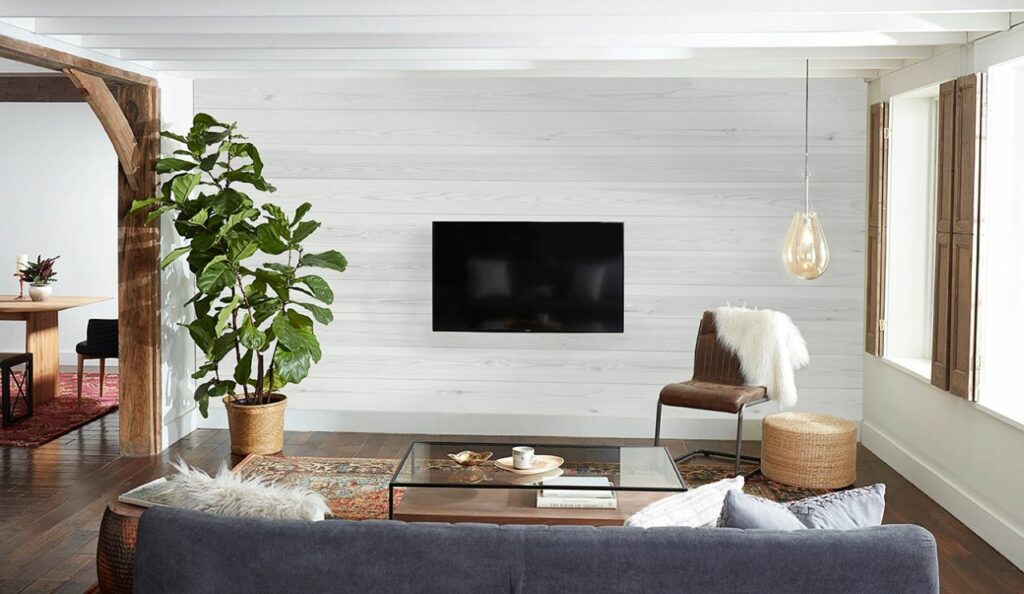
Whether you don’t have enough space or your TV console is not completely functional with the setup, you can install a wall-mounted TV for a minimalist look. It gives you the freedom to avoid unwanted furniture. It is particularly useful in secondary viewing areas, such as the kitchen or bedroom. This also looks amazing in a farmhouse-style interior. You can also consider installing a shiplap accent wall for this look to add visual interest and subtle texture to anchoring a TV in an overall rustic layout.
Wall-mounted TV with floating shelves

The floating shelves are also a low-risk design option with a high visual impact. It is great for balancing the “black box effect” that’s typically created by a flat-screen TV.
Install TV on a wood accent wall
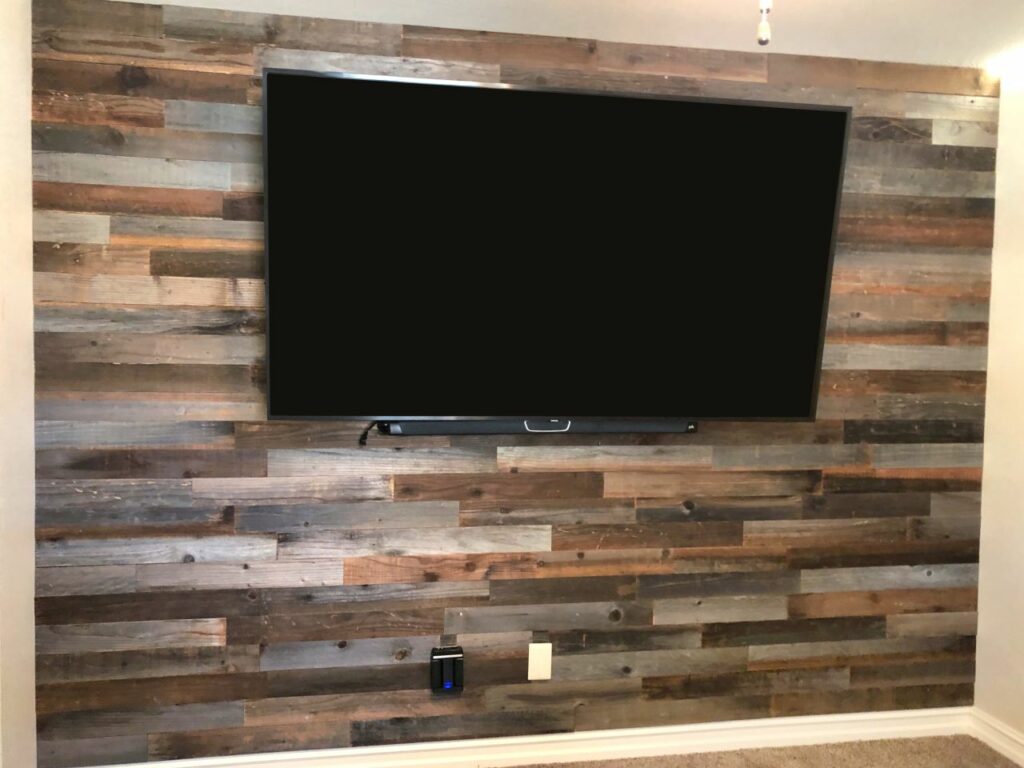
This particular faux wood or natural wood is a stylish and contemporary alternate shiplap. Its gentle sheen and subtle grains go well with modern interiors. Plus, the wooden backdrop gives a nice appeal to a wall-mounted TV.
TV on a dark wall looks amazing and it will definitely cheer you up
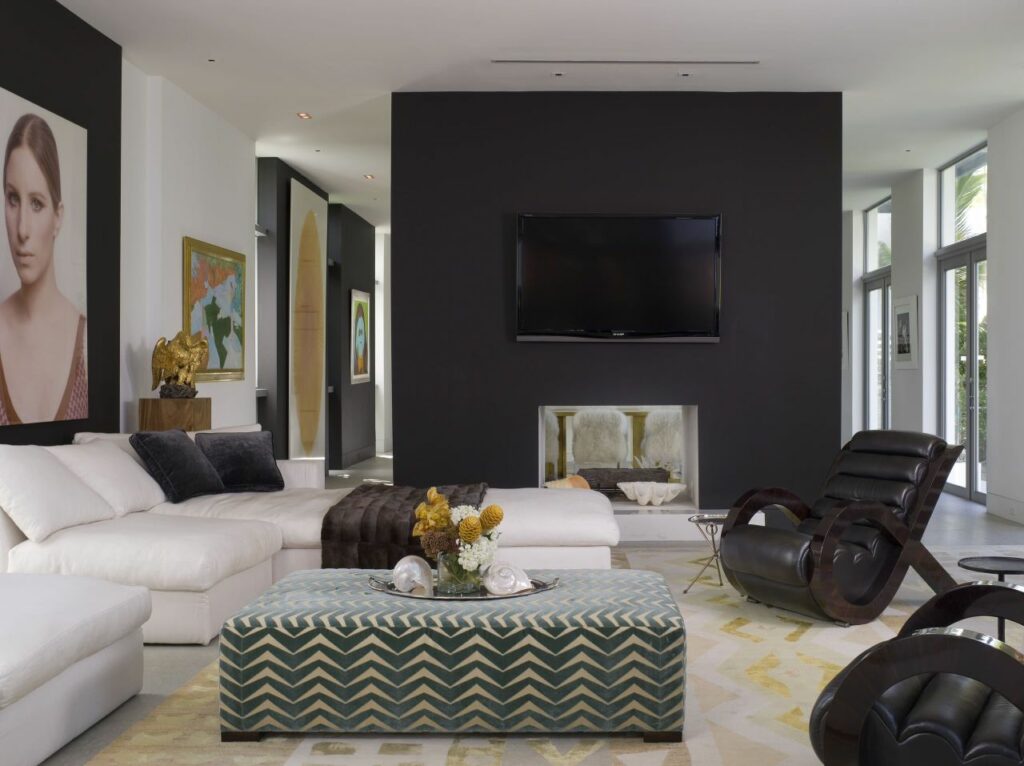
A dark TV wall may add all the drama in a sophisticated way for downplaying a TV’s impact on a room. But with the dark scheme, it does not only mean you are limited to black or black-like hues. There is a wide range of shades like charcoal, navy, jewel tones, and more that work equally well with this specific trend.
TV built right into the wall
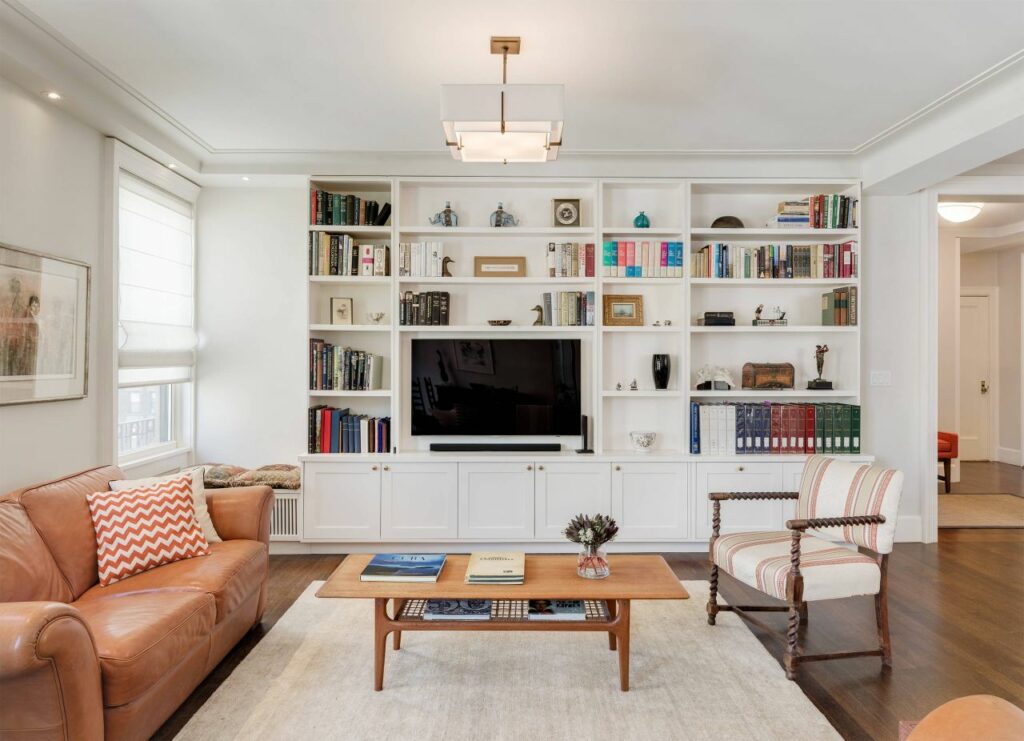
Wondering where to keep TV components with a sleek TV wall mount? Well, you have various options to store your cable box and other devices including media furniture, smaller streaming devices, and other gadgets. For this, you can choose to install a TV into a wall, creating a separate media wall.
Follow Homecrux on Google News!


